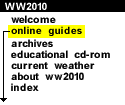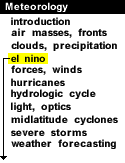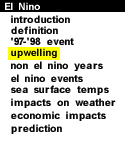
|
One oceanic process altered during an El Niño year is upwelling, which is the rising of deeper colder water to shallower depths. The diagram below shows how upwelling occurs along the coast of Peru. Because of the frictional stresses that exist between ocean layers, surface water is transported at a 90 degree angle to the left of the winds in the southern hemisphere, 90 degrees to the right of the winds in the northern hemisphere. This is why winds blowing northward parallel to the coastline of Peru "drag" surface water westward away from shore.
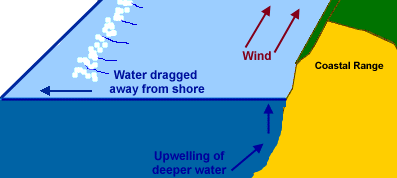
Nutrient-rich water rises from deeper levels to replace the surface water that has drifted away and these nutrients are responsible for supporting the large fish population commonly found in these areas. The effectiveness of upwelling and its ability to support abundant sea life is greatly dependent upon the depth of the thermocline.
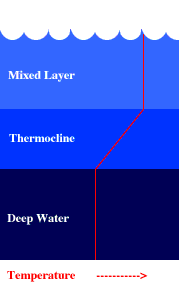 |
The thermocline is the transition layer between the mixed layer at the
surface and the deep water layer. The definitions of these layers are
based on temperature.
The mixed layer is near the surface where the temperature is roughly that of surface water. In the thermocline, the temperature decreases rapidly from the mixed layer temperature to the much colder deep water temperature. The mixed layer and the deep water layer are relatively uniform in temperature, while the thermocline represents the transition zone between the two. |
A deeper thermocline (often observed during El Niño years) limits the amount of nutrients brought to shallower depths by upwelling processes, greatly impacting the year's fish crop.

'97-'98 event |
|

non el nino years |
